The core of Fiesta Candelaria is the music and dance festival and competition. On the first Sunday of February about 100 indigenous dance groups from the villages of the Andes perform along with their bands of flutes, panpipes and drums. The performance at the stadium in Puno goes on for about twelve hours, one group after the other, and then they dance through the streets, a parade that goes on for even longer.
On the second Sunday it’s the turn of the dance groups from the various neighbourhoods of Puno. These dances are called traje de luces, or suit of lights, and are essentially an expression of the history and spiritual practices of the Mestizo people of the Andes, a rich concoction of traditional and Catholic expression. There are dances related to fertility, sowing and harvesting, mining activities, the black slave community, the Spanish Conquistadores, and most important of all the Diablada or devil dance: a fight between good and evil that arose from the rescue of some trapped miners who prayed tirelessly to the Virgin of Candelaria. There are hordes of devils dancing in the stadium on this day. And countless pretty girls with high boots, higher skirts and angel wings.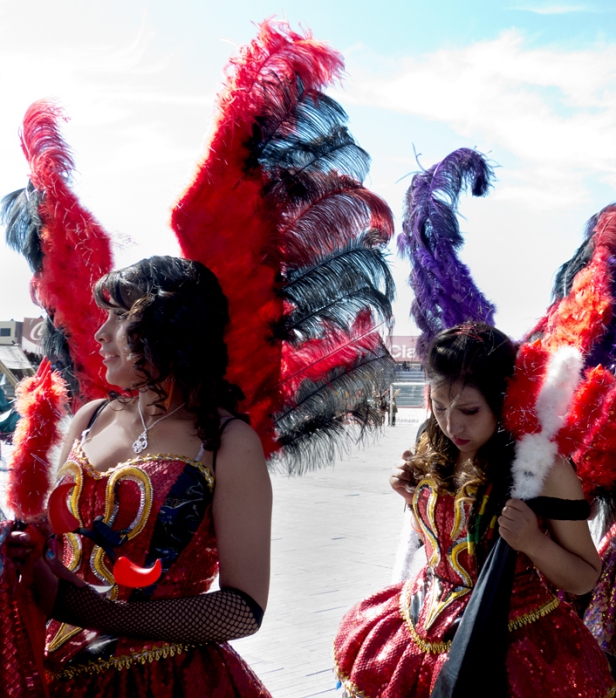

There are eighty different dance groups. Almost every group has its own 50-member brass band, and the remainder have equally large traditional panpipe and drum bands. That’s a lot of tubas and trumpets and drums. And a lot of dancers. Every group has four to five hundred dancers filling the dance ground. The sheer size, scope and colour of it all is truly spectacular. You can’t help but be swept up in the excitement as group after group lines up to take their turn.
There are characters in these dances that both dazzled and puzzled us.
Who are they, what do they represent?
There are gorillas (or something like),
wild creatures with axes,
even wilder feathered beings covered in skulls,
the biggest shoulder pads on the face of the earth,
panda bears, or maybe polar bears, dressed in bikinis and covered in spiders,
characters with outrageously long noses,
a band of men dressed as jaguars,
skeletons,
a condor (or something like),
a couple of slaves with ball and chain,
girls with feathery wings and a headdress of snakes,
a witch with hooked nose and tall black hat,
entire companies of Indians
in leather skirts or pants, feathered headdresses and war paint,
sparkles and beads and sequins and glitter,
and much much more.
Just when we thought we’d seen it all a new apparition would appear before us.
Because there hasn’t already been enough dancing and parading and blowing of trumpets and pipes, on the Monday after the second Sunday of the dance competition there is a parade through the streets of Puno. Every group participates, drinking beer along the way, energized by the raucous crowds.
Some of the photos are of the traje de luces at the stadium, some were taken at the parade the next day. Where you see a photo with one or two or only a few dancers, imagine hundreds of dancers, all dressed alike. I started with over 1000 photos. I had trouble eliminating. It’s the most photos I’ve ever put in one post. I wanted to share everything but couldn’t possibly; it’s just a taste. If you click on them, especially the smaller ones, you’ll get to see much more detail. The detail in some of the costumes leaves me awestruck; hours weeks months of labour to produce exquisite works of art.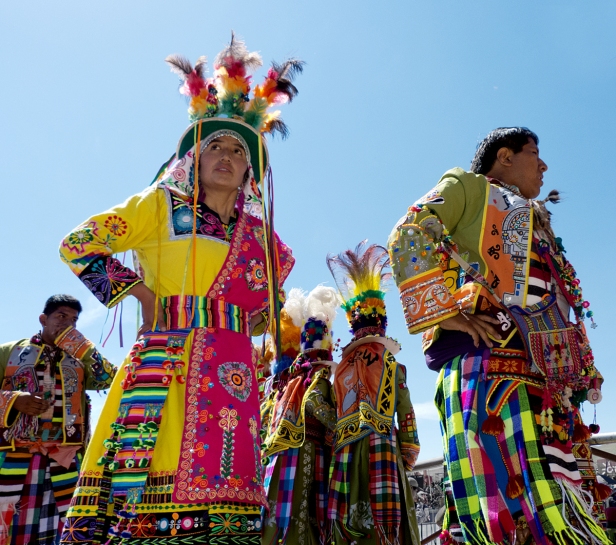
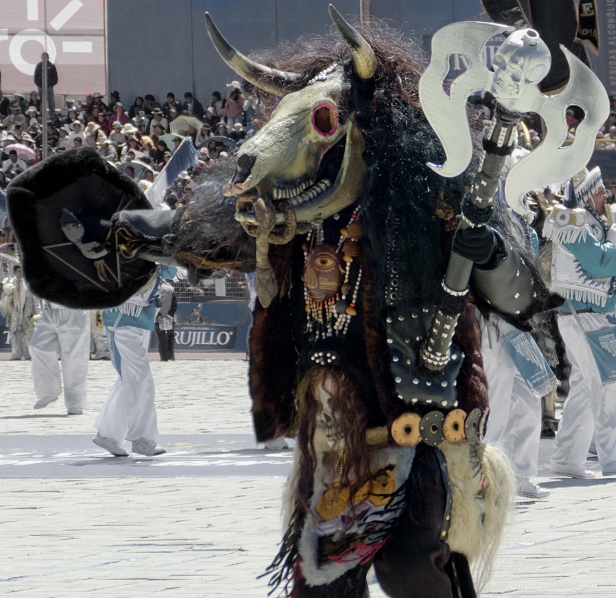
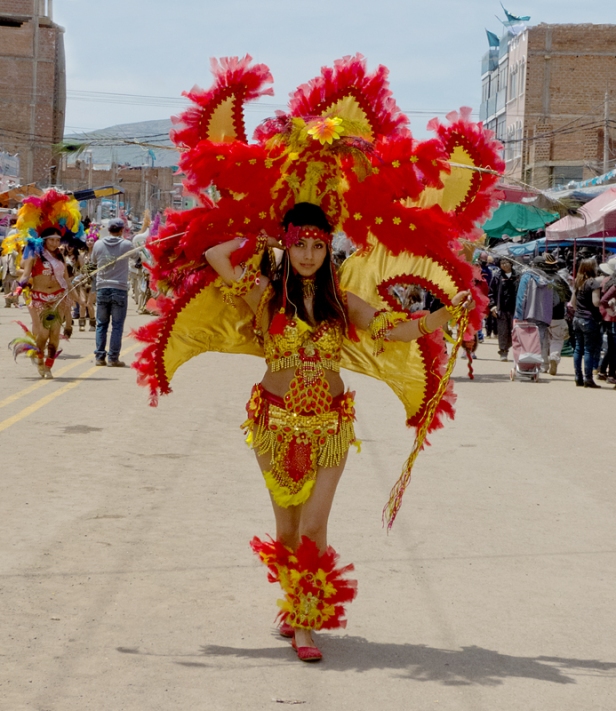
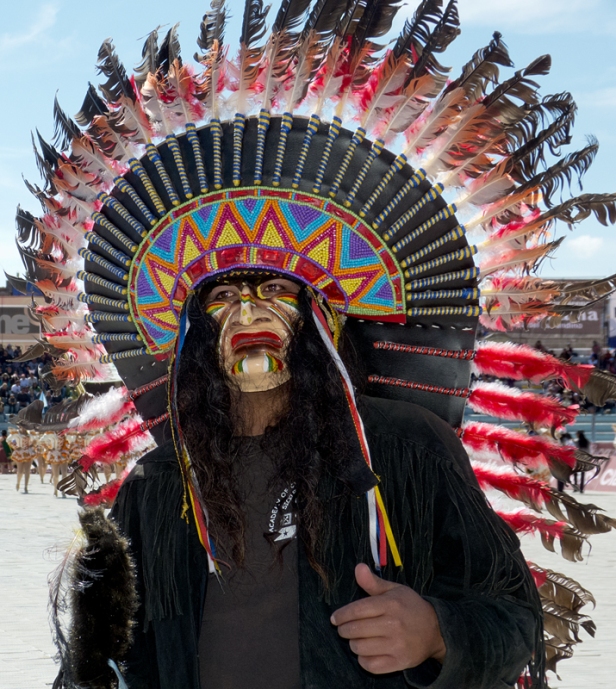
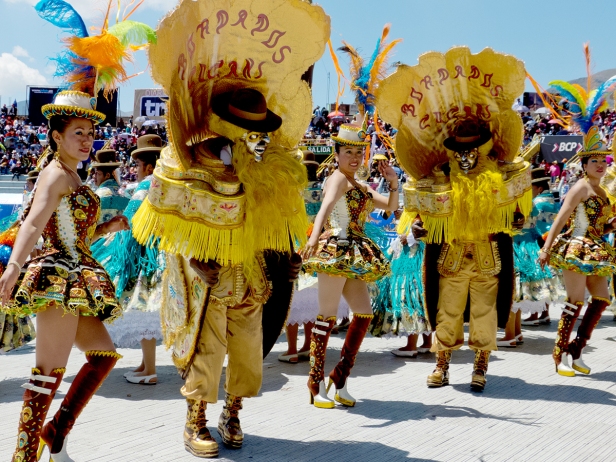


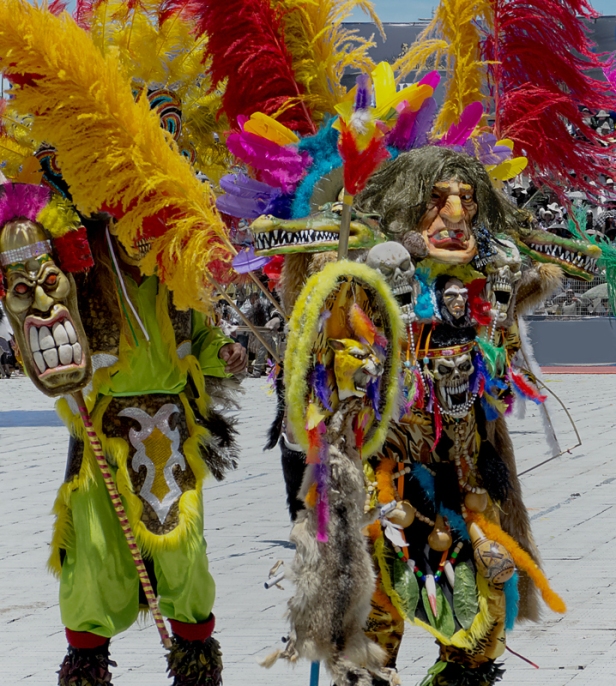


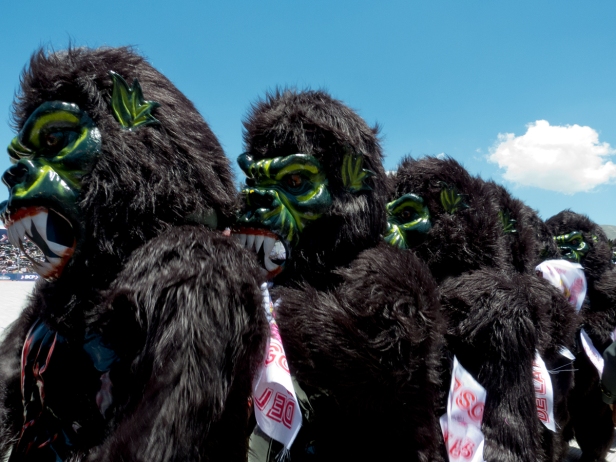
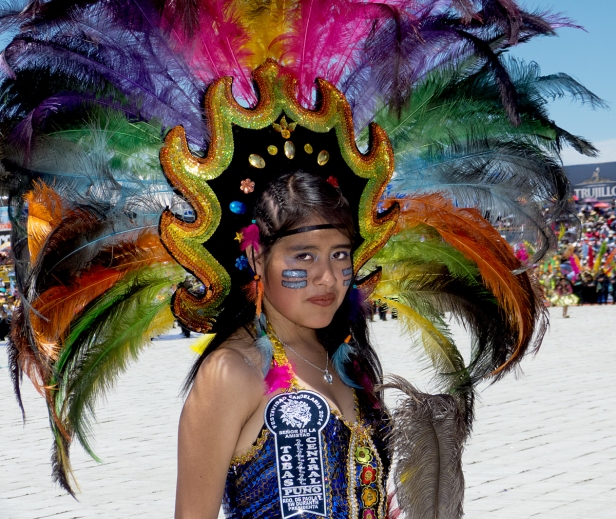



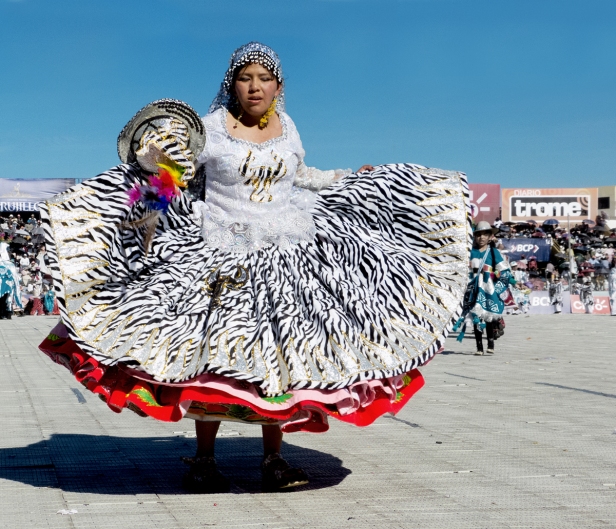


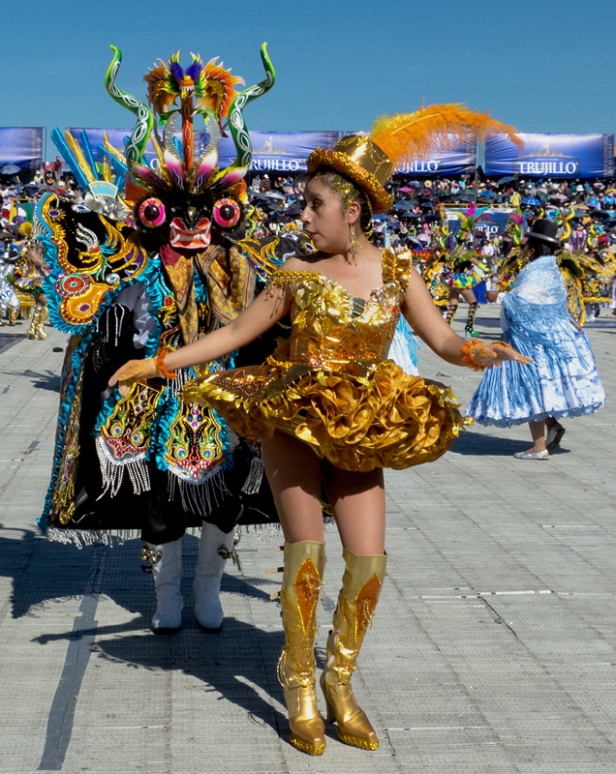
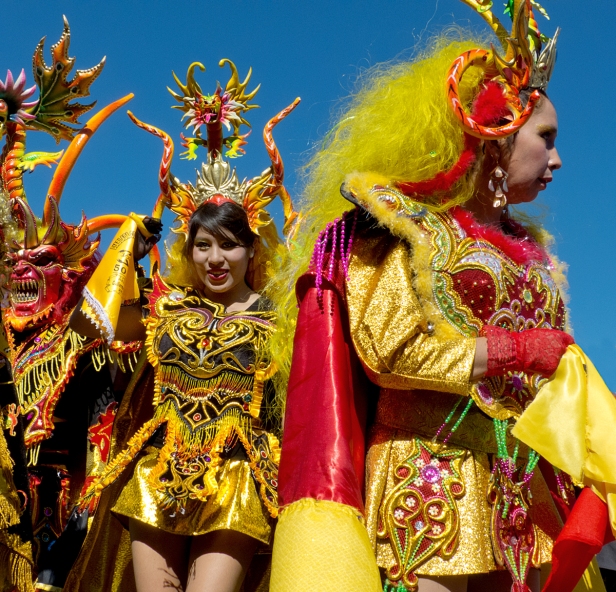
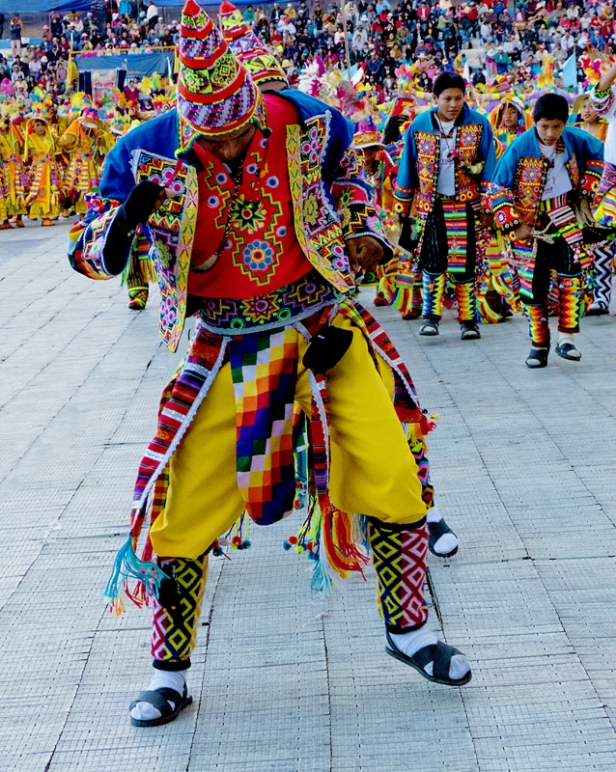
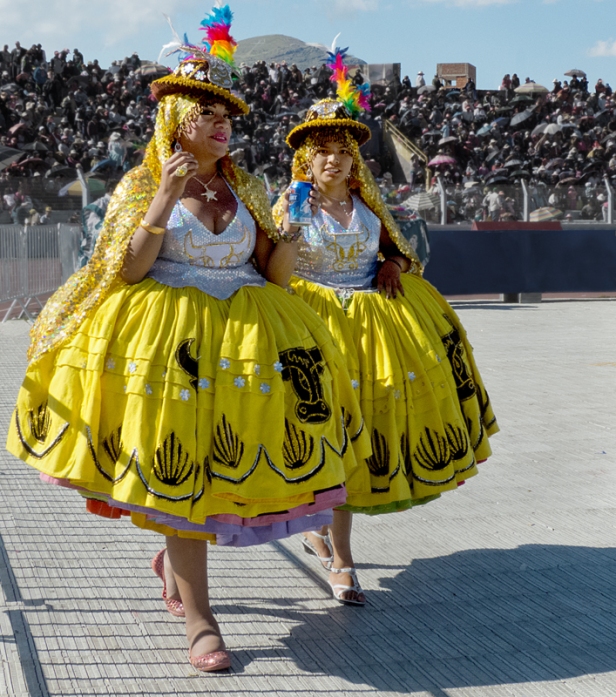
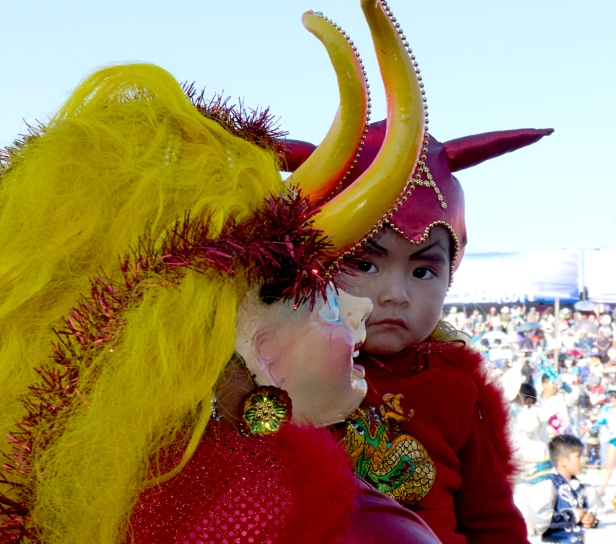
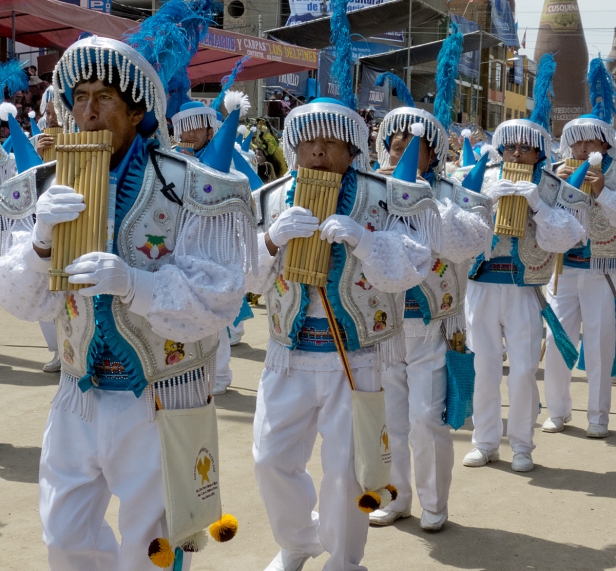
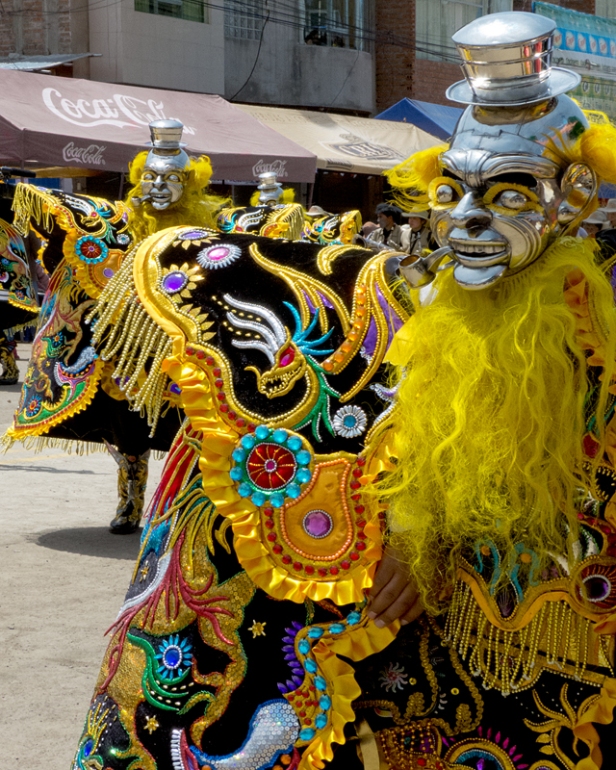
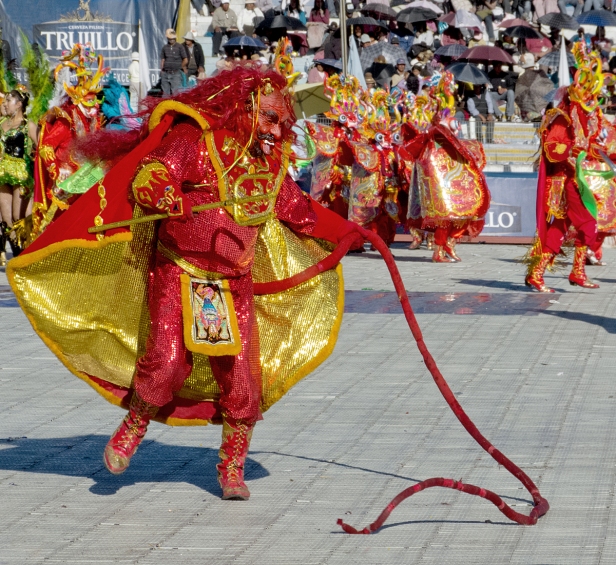
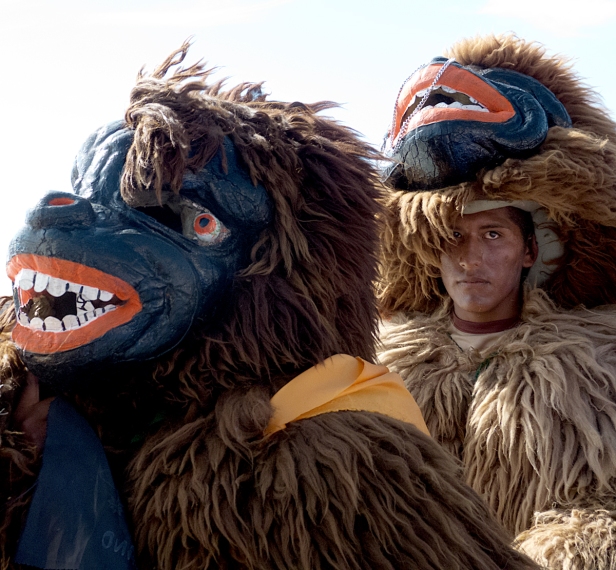
Time for a smoke break.
Imagine this – a football field filled with 500 dancers, half of them men, dressed like this, each group in a different colour,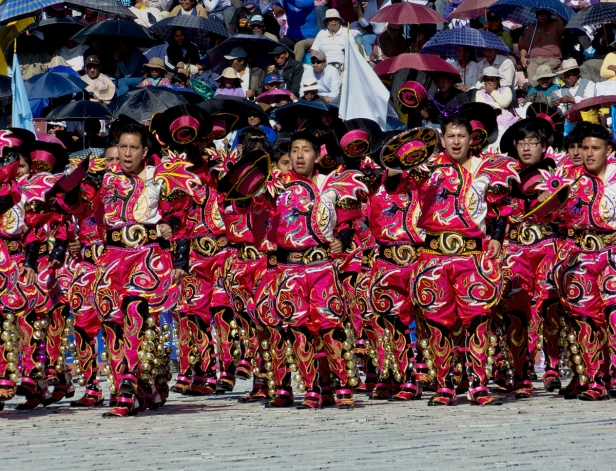
and half of them women dressed in high heels, perky little hats, next to nothing skirts and enough glitter and sequins to light a city, in matching colours, all 500 of them dancing in carefully choreographed patterns at a hundred miles an hour. Breathtaking!
Or else it’s a few hundred devils,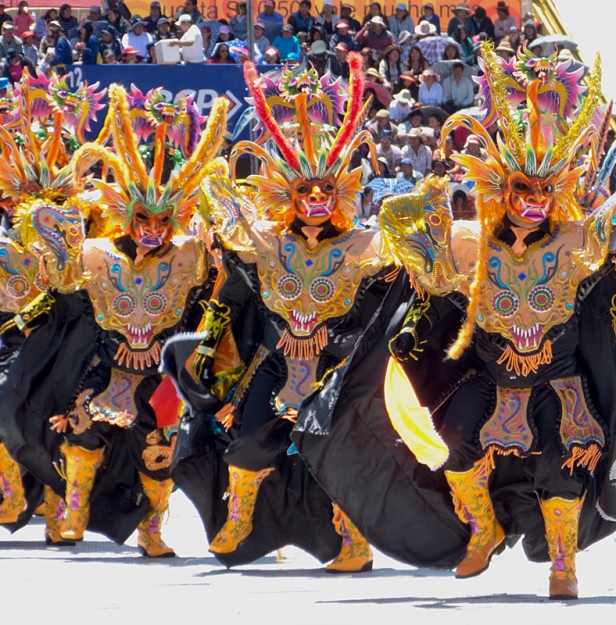

or men in hooped skirts and bearded masks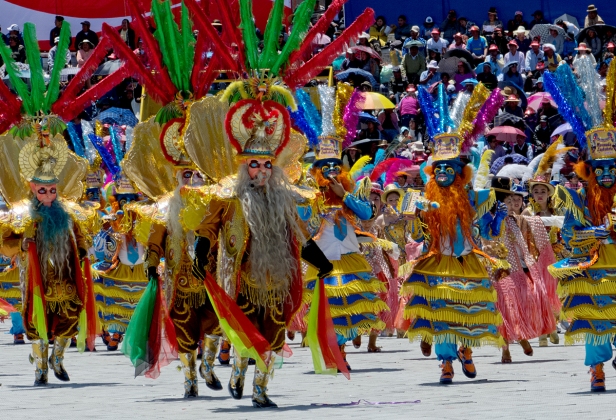

Best shoulder pads ever!
Best eyelashes ever!
Time for the band to take a break. I was especially impressed with his ingenious seating arrangement.
This photo was taken as the parade moved down one of the main streets of Puno. Beer rules!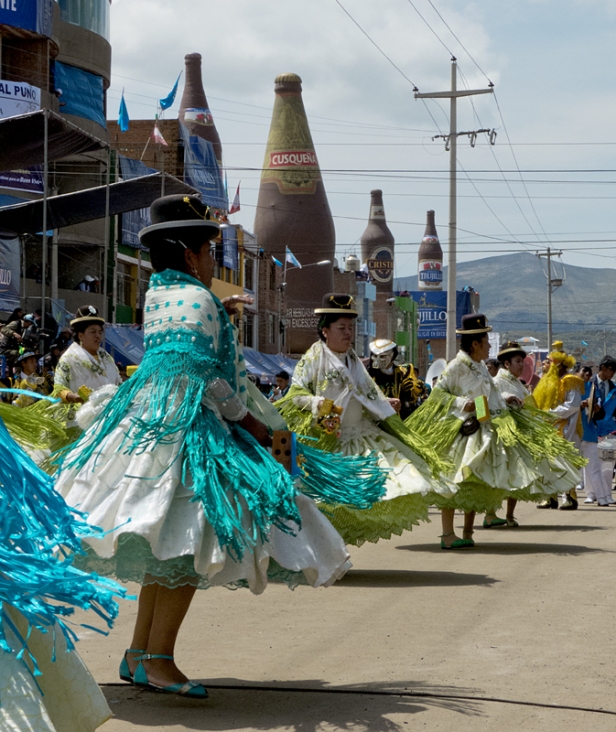
Surprisingly this girl does not have beer. She has the ubiquitous Peruvian soft drink called Inca Kola.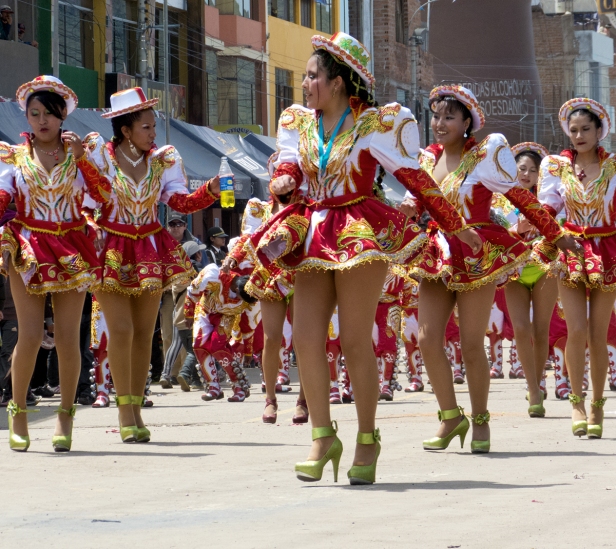
We were in town for eleven of the eighteen days of Candelaria. There was more after we left: a parade of the panpipe bands, more parades of the effigy of Candelaria who was eventually returned to her home church, and a trip to the cemetery to honour the dead. But eleven days was enough. We felt completely filled with it, with the music, the dancing, the joyous spirit. It’s a celebration of truly heroic proportions, and we’re so glad we were there for it.
You want more about Candelaria? There’s a good article by Tyler Cole here
Next post: Ecuador’s capital Quito with the goldenest church in the world, Otavalo with the biggest indigenous market in South America, and climbing a volcano in heinous weather.
All words and images by Alison Louise Armstrong unless otherwise noted
© Alison Louise Armstrong and Adventures in Wonderland – a pilgrimage of the heart, 2010-2015.

awestruck indeed about the details in those costumes! Amazing work. Must have been overwhelming visually to see all this for days in a row. I bet they work all year on those costumes, and then start all over for next year.
I got a real laugh over the detail that appeared when the purple-haired guy lifted his skirt…
LikeLike
Definitely visual overwhelm – but in a good way. It was incredibly exciting. And we did pace ourselves. There was some repetition in the types of dance groups even if they all had their own colours, so we could take much needed rest breaks.
I hope that the costumes last more than one year, some of them anyway (like those gorgeous yellow capes). But there are vast numbers employed making the costumes and masks and I bet they’re continually employed. The festival is a huge industry there and an important part of the economy.
Isn’t that purple haired guy a delightful surprise?!
LikeLike
Love the photo of the guy sitting on the two beer bottles!
LikeLike
Too clever for words! I took several pics before the other guys alerted him that I doing that, so then he tried to turn around to see me but obviously couldn’t turn too far.
LikeLike
Fantastic costumes. You must have had an absolutely amazing time watching the different dances and listening to the music!
LikeLike
It was a spectacular time. Such a richness of creativity, history, joy, colour, and community. You could tell they are very proud of their party (as they call it), and rightly so.
LikeLike
Wow… you said it, this is of “Epic proportions” only 🙂
The costumes are just amazing and what a great variety…
Thanks a lot for sharing 🙂
Have a great time…
LikeLike
You’re welcome Sreejith. The costumes, and the dancing had us both completely dazzled. Epic!
LikeLike
Phenomenal post and photos! I’m not surprised you took a thousand pictures – with this swirling eye candy all around you, how could you not? When in a highly photographable situation, I always feel a bit conflicted between capturing images and just experiencing it fully without a camera standing between me and the action. I’m very grateful that you went to the effort to record these images and share them with us. I’ll bet it was exhausting, especially at over 10,000 feet of altitude!
LikeLike
Thanks Silk. It was a phenomenal experience! I know what you mean about the conflict between photographing and just watching and taking it in. Fortunately in this case there was so much of it I was able to do both and don’t feel as if I missed out, though I must say that when I’m travelling the camera does get in the way at times. It was exhausting (12,500 ft!) but we were able to pace ourselves, and it was so exciting we’d forget to be tired! (Until it could no longer be denied and we’d crawl back to the hotel and collapse for a few hours).
LikeLike
Fabulous! These are just the types of events one hopes to participate in when traveling. Your photos are great-I especially like the beer bottle seat!
LikeLike
Thanks so much. We’re very glad we were able to go. It was certainly a once in a lifetime thing. I too especially like the beer bottle seat 🙂 Very inventive.
LikeLike
What amazing costumes! I would love to witness something like this. Thanks for sharing.
LikeLike
Oh it was amazing Darlene. We were just bug-eyed. It’s a pleasure to be able to share it.
A
LikeLike
Absolutely amazing! I hope you were able to sit while you watched it. I think if it was me, I would need some down time afterwards…all those bright colours and music for that long period of time would be a bit over-stimulating for me I think. I would have loved to have been there though!
LikeLike
Definitely amazing! I didn’t sit. I was too busty photographing. We were in the area for people with press credentials – a full-sized athletic track between the stands and the dance ground. The view from the stands was not good so I’m glad we got press credentials. There was a small shaded seating area in there that I think was there for the main Peruvian TV people but I used it anyway from time to time, and even got interviewed for Peru TV lol (with my barely existent Spanish). After a few hours we definitely needed a break so collapsed in out hotel room for a while then went back out again. There was certainly a saturation point where we couldn’t take in any more, but taking a break was all we needed.
LikeLike
Wow!! So much colours in there 🙂 It looks amazing! 🙂
LikeLike
It was spectacular! We’ve been to a few festivals around the world, and this is definitely one of the best.
LikeLike
Fantastic costumes. It is hard to imagine the incredible number of hours and cost, not to mention the creativity that goes into creating them. Great blog. I am starting to think that a trip to Peru is definitely in order. –Curt
LikeLike
Thanks Curt. Hours, cost, dedication. I think performers pay for their own costumes. I read an entire month’s salary, but that a seems low to me. The festival is a huge part of the economy of the area. Stunningly creative.
We spent 2 months in Peru – Uros Islands, Candelaria, Andes Mountains and villages, Inca and pre-Inca ruins, Machu Picchu, the Amazon – definitely worth a visit!
A
LikeLike
Peggy was asking me the other day about my list of places I want to visit next. Machu Picchu has been on my list forever. You and Don have inspired me to think about the rest of Peru. Thanks. –Curt
LikeLike
It is definitely a country worth exploring. The whole inca/Andes experience, and our Amazon experience was . . . . . amazing. If you go to the Uros Islands I really recommend a 2 day home stay (links to an article about that on my post about Uros).
A
LikeLike
I think you are planning out our trip. 🙂 Thanks.
LikeLike
Glorious explosion of color in all of your photos! Definitely epic event!
LikeLike
Yes, glorious. And spectacular. And breathtaking. It was incredibly exciting to watch. Definitely epic. We really has no idea what we’d signed on for except I read online that it was one of the big 3 festivals in Sth America along with Rio’s Carnival and a festival similar to this one in Oruro, Bolivia. I’ve never been to Carnival, but it is all about samba dancing. I loved the variety in this festival. EPIC!
LikeLike
One word – fantastic! Thanks for sharing. Bye. Kamila
LikeLike
Thanks so much Kamila. And you’re welcome. I’m glad you enjoyed it. It really was amazing.
Alison
LikeLike
how you manage your 1000+ photos amazes me! your selection here really demonstrates the beauty of the culture and how much pride they have keeping it fresh and festive. no shortage of beauty here that’s for sure. wonderful party!! 🙂
LikeLike
Sometimes managing the photos can definitely be a bit daunting, but every time I seem to manage to sort through them, with Don’s help. I know I also face thousands when I get to the Galapagos photos.
A wonderful beautiful party – they were all so proud of their culture, and their festival, so enthusiastic. And rightly so. It was a fabulous experience to be there for it.
LikeLike
Let’s hear it for thousands of Galapagos photos, enjoying the party as I wait..
LikeLike
Quito and area next 🙂
Then, finally, Galapagos.
You are very patient 🙂
A.
LikeLike
I am impressed that you managed to sort through all your photos and narrow it down to only the ones shown here. What an amazing event for all the senses – eyes, ears, nose. Looking forward to the goldenest church. 🙂
LikeLike
Yes, a very amazing event. We’re so glad we went. Sensory overload – in a good way 🙂
The goldenest church left us completely gobsmacked!
LikeLike
You have me dancing and putting this one in my diary! Best to you both and thanks for wonderful post! Mucho wow wow wow!
LikeLike
Thanks so much Anne. Glad I got you dancing! And do go! It’s quite extraordinary and fabulous. Alison
LikeLike
I was out of breath just looking at the pictures let alone experiencing eleven days of dancing. Mind you, where I come from if they discovered a virgin they’d throw a party too.
LikeLike
Chuckle chuckle chuckle
We were plenty out of breath, both from the amazing spectacle of it all – one thing after another that left us completely gobsmacked! And from the altitude – 12,500 ft!
LikeLike
Absolutely visually and culturally rich series of photos and narrative. What a glimpse this renders of culture and place. Impressive~
LikeLike
Thanks so very much Cindy. We’re very glad we went and felt truly saturated with the splendour and richness of it all. They’re all so very involved. Just about everyone is a musician, or a dancer, or organizer, or costume or mask maker, or is involved somehow with the church proceedings, or the parading of the Candelaria statue, or builds and lights the fireworks towers. The whole community comes together in grand celebration. The energy was fabulous.
LikeLike
This post is making me think long and hard about revamping my wardrobe. Maybe show up at the next project meeting in a devil’s outfit with the head of Skeletor hanging from a chain around my neck. I think if someone were to show up unannounced in this area around the time of this festival with a cart full of those batting helmets with built-in beer holsters and ready-made plumbing, maybe painted cerulean and bedazzled with feathers and fake mohawks, they would become an overnight national hero. I’m not talking about selling them, folks. I’m talking about crashing the party… 🙂
Michael
LikeLike
ROFLMAO! I do try not to resort to net abbreviations, but it captures our reaction so succinctly 🙂
Aren’t those costumes the ultimate in creative and outrageous! And this is not even all of them. I agree that they would probably love those beer helmets even more than their bedazzlers. Come crash the party!
LikeLike
I had to look that one up. Love it! Yes, the costumes are amazing. I probably read it and didn’t retain it, but is that a one day, a weekend, a week long festival? The images make it look like the whole country takes to the streets for the summer, but I suppose it could just be a really, really good weekend?
Michael
LikeLike
18 days. We were there for 11 of them.
LikeLike
So your readers will be curious to know, what is the proper ratio (for planning purposes)? One day at the Festival of the Virgin of Candelaria to seven days of recovery? One to five if we seek the services of a top notch cranio-sacral therapist? What are we looking at here? We need to understand the fine print.
🙂
Michael
LikeLike
Ha! Recovery! Wot’s that?! With only a day between we went from Candelaria to 8 days hiking/boating/swimming/exploring in the Amazon 🙂
Here’s the ratio you’re looking for – 6 months travel in South America to 2 months glorious slothfulness on Cyprus.
A
LikeLike
Great series of photos. I love the costumes.
LikeLike
Thank you so much Linda. Yes, we love the costumes too – so beautiful and spectacular.
Alison
LikeLike
Have a great weekend, and warm greetings from Montreal! 🙂
LikeLike
Thanks Linda. You too!
A.
LikeLike
Truly amazing ~ those photos are beaming with energy! I can see why it was hard to sort out which ones to show or not.
The high octane bursts of color are just exquisite, the costumes all have an energy to themselves. I can’t imagine what this all looked like swirling around you guys in person.
Brilliant post as always!
~Andrea ❤
LikeLike
This festival was one of the most amazing things we’ve been to. I’m so glad we were there for it. Aren’t the costumes just spectacular?! The time and effort put into this whole festival is truly epic. The entire town and surrounding area is involved and it’s a huge part of the economy.
Alison ❤
LikeLike
As we like to say down here in Colombia, ¡¡GUAU!! What a fantastic showcase of the local culture that really covers the waterfront, celebrating everything from fertility to dancing devils. And of course your photography is spectacular, showing not only the pageantry but the quieter moments (like the smoke break guy and and dude sitting on bottles!). I completely relate to the dilemma of having thousands of photos to sort through – it reminds me of our experience with Colombia’s Carnaval back in January. In fact, this celebration reminds me a bit of that carnaval, but on steroids. Thank you for sharing this unique experience.
LikeLiked by 1 person
Thanks so much Susan. GUAU!!!!! indeed (what a great word!). It was the most amazing time, from the first day we arrived in town until the day we left. I’m not surprised that Columbia’s Carnival is similar. I think the same historical and mythic characters seem to have spread pretty much throughout South America, certainly through the Andes populations from south to north.
One of my fave things to do when travelling is to go to festivals. We found out about Candelaria by chance and changed our plans to attend. I’m so glad we did.
Alison
LikeLike